Victorian fireplaces are some of the most iconic and enduring architectural features from the 19th century. Beyond their practical role in heating homes, they represented status, craftsmanship, and artistic expression.
Today, they remain highly sought after, both by homeowners restoring period properties and by those who want to introduce a sense of history into modern interiors.
This comprehensive guide explores the history of Victorian fireplaces, their defining styles, the restoration process, costs, and how they can be incorporated into today’s homes.
Estimated reading time: 8 minutes
Table of contents
The Historical Significance of Victorian Fireplaces
During Queen Victoria’s reign (1837 to 1901), the Industrial Revolution transformed Britain’s cities and homes. Fireplaces evolved from being purely functional to decorative focal points, reflecting prosperity and taste.
- Industrial Advances: The mass production of cast iron allowed intricate patterns and detailed designs that had previously been impossible. Fireplaces became more affordable and widespread.
- Social Symbolism: The fireplace was often the centerpiece of a room, a place for families to gather, entertain, and display wealth.
- Regional Differences: In London townhouses, fireplaces tended to be tall and elegant, while in northern industrial cities, they were more compact and utilitarian.
By the late Victorian period, fireplaces had become smaller as advances in coal efficiency meant less heat output was needed.
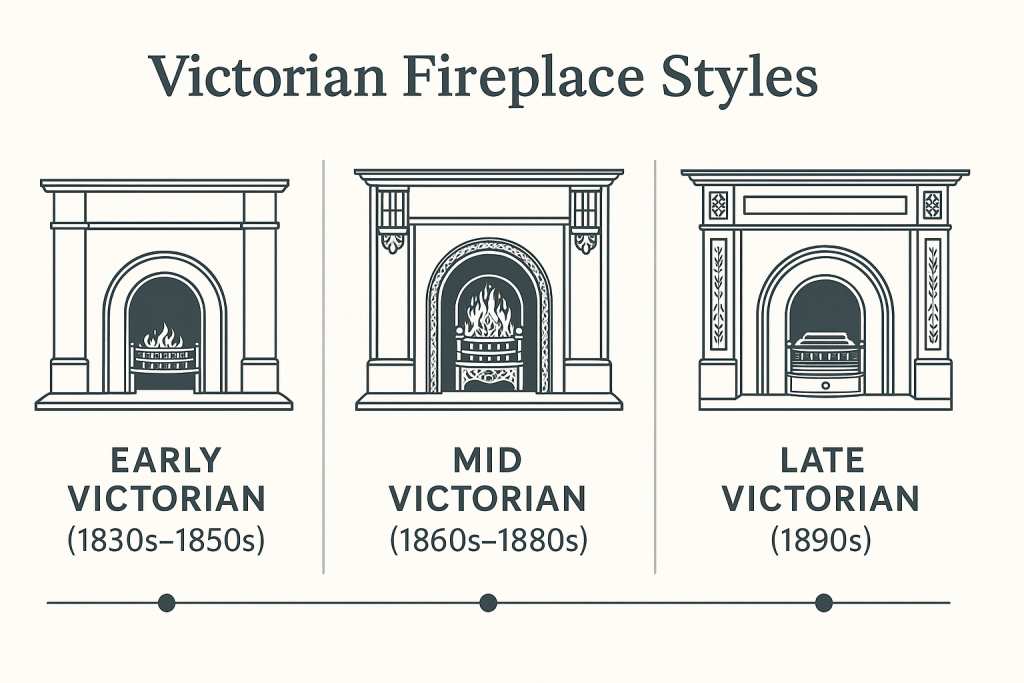
Popular Styles of Victorian Fireplaces
The Victorian period produced an extraordinary variety of fireplace designs. Each reflects the trends of its time:
1. Cast Iron Fireplaces
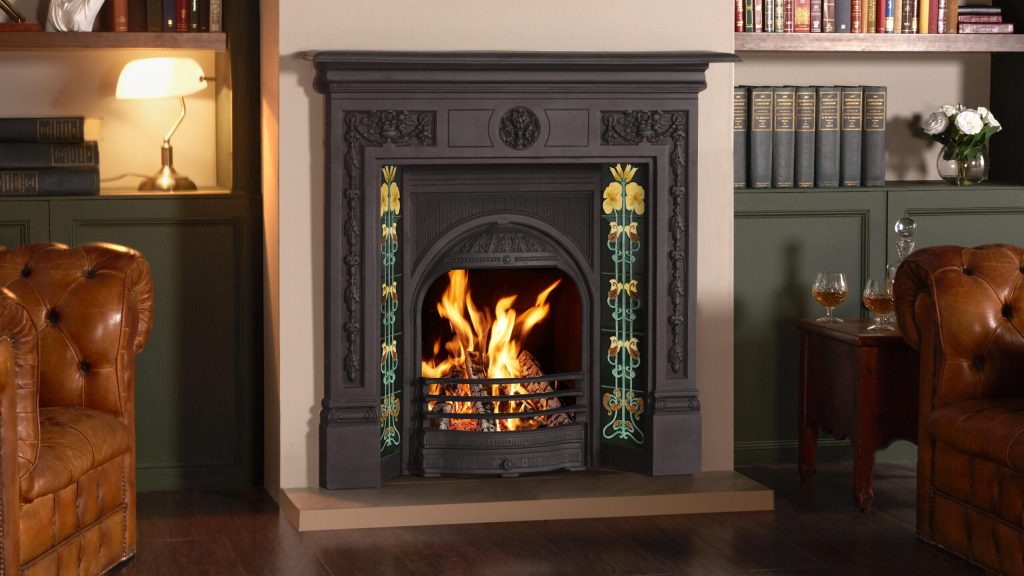
The workhorse of the Victorian home. Cast iron could be molded into floral patterns, geometric motifs, or even entire scenes.
Often combined with tiled inserts, these remain among the most common reclaimed pieces today.
2. Marble Fireplaces
Favored in the grandest rooms, marble surrounds offered elegance and a sense of permanence.
White Carrara marble was most prized, but black Belgian marble was also fashionable.
Carvings might include Corinthian columns or classical figures.
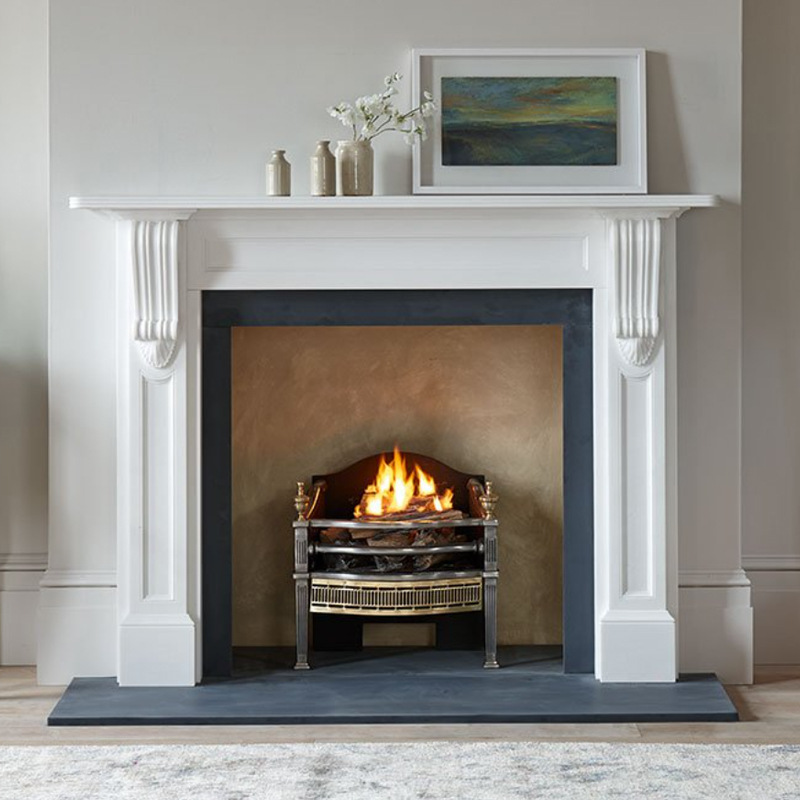
3. Slate and Wooden Surrounds
Painted slate that imitated marble offered a cheaper alternative, while oak and mahogany mantels appeared in middle class homes.
Wooden surrounds often featured hand carved scrolls or Gothic arches.

This fireplace features wooden corbels which offers a modern Victorian style.
4. Tiled Fireplaces
By the 1880s, brightly glazed tiles, often produced in Stoke on Trent, adorned fireplace cheeks.
Common motifs included sunflowers, ivy, and symbolic imagery tied to the Aesthetic and Arts & Crafts movements.

Tiled cast iron inserts can transform Victorian fireplaces by combining ornate ironwork with colorful ceramic tiles, creating an elegant focal point that complements period interiors.
They can be used to enhance both original and restored fireplaces, adding authentic style and decorative detail characteristic of the Victorian era.
5. Bedroom Fireplaces
Smaller and simpler, these were typically cast iron with minimal decoration. Today, they are especially popular in period property restorations.
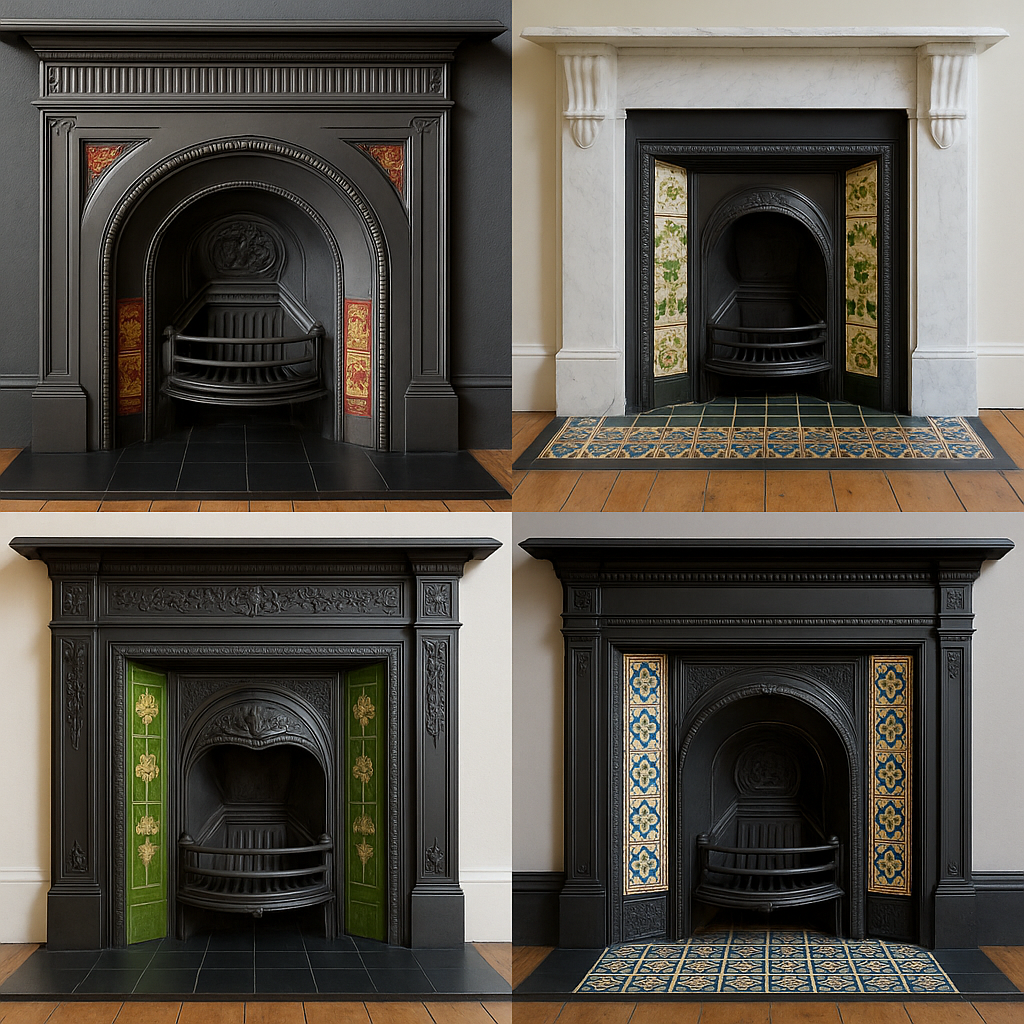
Restoring a Victorian Fireplace
Bringing a Victorian fireplace surround back to life requires careful planning.
Here’s a detailed process:
Step 1: Initial Assessment
- Look for cracks in the iron or marble.
- Check if tiles are intact or need replacing.
- Inspect the chimney for blockages or structural damage.
Step 2: Cleaning and Surface Preparation
- Cast Iron: Remove rust with a wire brush or professional sandblasting. Finish with black lead polish for the traditional sheen.
- Marble: Clean with non abrasive products. Chips and cracks can be repaired by stonemasons.
- Tiles: Use pH neutral cleaners; avoid acids that strip glaze.
Step 3: Repair or Replace Missing Elements
Reclaimed salvage yards and specialist suppliers offer authentic grates, tiles, and surrounds.
Reproduction pieces can fill gaps without compromising the look.
Step 4: Professional Safety Work
Always consult a certified installer. Flues may require lining, and some chimneys need reinforcement before use.
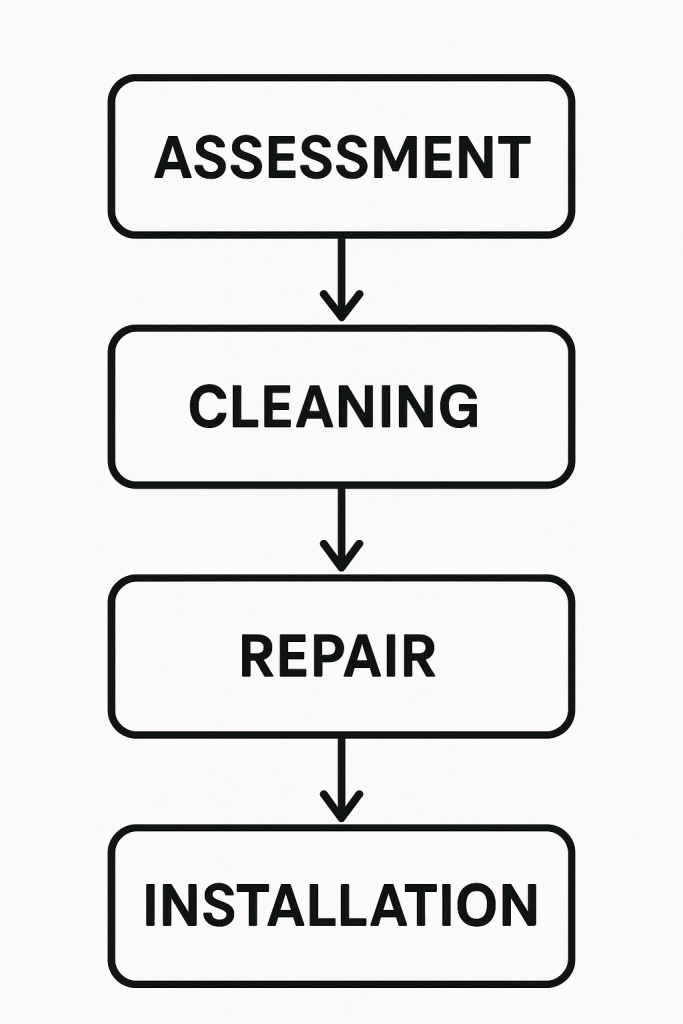
Costs of Victorian Fireplaces
The cost of owning a Victorian fireplace depends on whether you’re buying, restoring, or reproducing one.
Please see our findings below:
| Type | Typical Cost Range (GBP) | Notes |
|---|---|---|
| Reclaimed cast iron fireplace | £400 – £1,200 | Common, wide availability |
| Original marble surround | £1,500 – £5,000+ | Rare, high end |
| Reproduction tiled fireplace | £700 – £2,000 | Affordable and authentic looking |
| Professional restoration | £500 – £2,500 | Cleaning, repairs, fitting |
| Chimney/flue work | £800 – £3,000 | Often necessary for safety |
Victorian Fireplaces in Modern Homes
Fireplaces may no longer be essential for heating, but they remain powerful design statements.
Here’s how homeowners are using them today:
- Living Rooms: A restored cast iron fireplace contrasts beautifully with neutral walls, providing a dramatic focal point.
- Bedrooms: Small Victorian bedroom fireplaces add warmth and charm, even when not in use.
- Contemporary Interiors: Pair a marble surround with minimalist furniture for a striking mix of old and new.
- Eco Friendly Conversions: Many people adapt original surrounds to house modern fireplaces, including bioethanol, electric, or gas stoves, offering sustainability without sacrificing style.

Are Victorian Fireplaces a Good Investment?
Yes, absolutely!
Here’s why investing in a Victorian fireplace can add value and style to your home:
1. Boost Property Value
Victorian fireplaces are highly sought after by buyers looking for period features, making your home more appealing and potentially increasing its resale value.
2. Unique Craftsmanship
Each original fireplace showcases intricate design and craftsmanship that cannot be replicated by modern mass produced alternatives, offering a one of a kind feature for your home.
3. Sustainable and Eco Friendly
Restoring antique fireplaces preserves history and reduces waste by reusing existing materials, making it an environmentally responsible choice.
4. Design Versatility
Victorian fireplaces suit a wide range of interiors, from classic Victorian terraces to contemporary apartments, blending timeless elegance with modern style.
Victorian vs Modern Fireplaces
Modern fireplaces, whether gas, electric, or contemporary wood burners, offer efficiency and low maintenance.
But they often lack the character of Victorian originals.
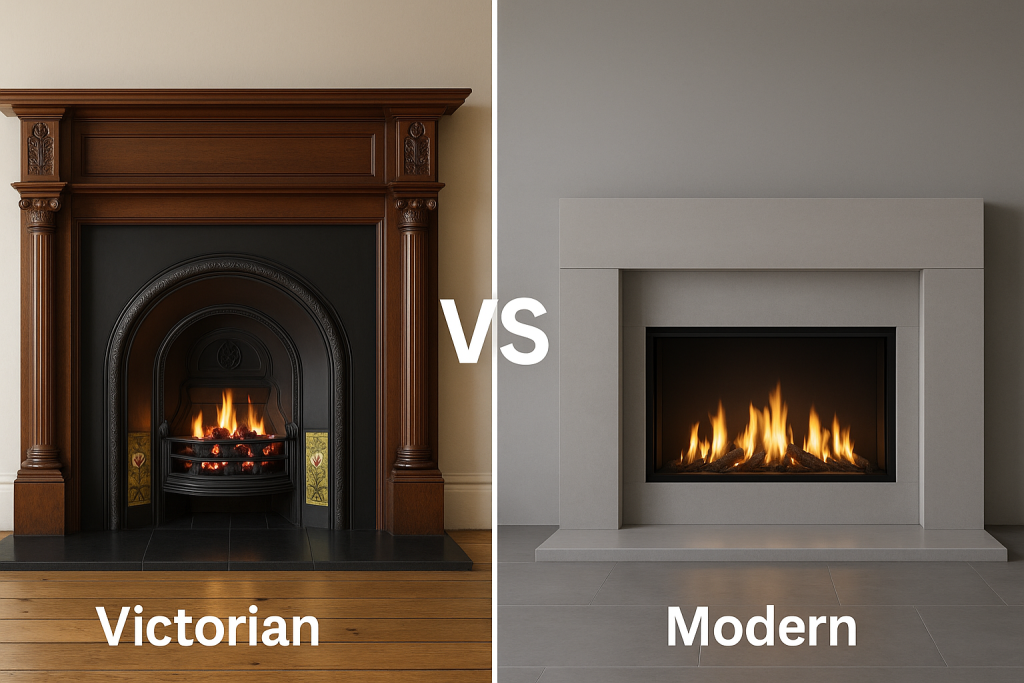
If you’re weighing the pros and cons, this excellent article breaks it down in detail: this guide on modern vs Victorian fireplaces by The Victorian Emporium.
Care and Maintenance Tips
Keeping your fireplace in top condition ensures it lasts another century.
- Cast Iron Care: Polish with black lead every 6 to 12 months.
- Tile Maintenance: Use mild soap and water only. For hairline cracks, consider professional tile restoration.
- Chimney Care: Have your chimney swept annually to prevent soot build up and blockages.
- Seasonal Checklist:
- Autumn: Inspect chimney before first use.
- Winter: Monitor draughts and ventilation.
- Spring: Deep clean fireplace and polish.
- Summer: Cover to prevent debris or bird nesting.
Final Thoughts
Victorian fireplaces are more than heating fixtures, they are heirlooms of history, art, and design.
Whether you restore an original, invest in a reproduction, or integrate one into a modern setting, they bring beauty and value to any home.
By understanding their history, styles, restoration processes, and costs, you can make informed decisions and enjoy the elegance of Victorian craftsmanship for years to come.



